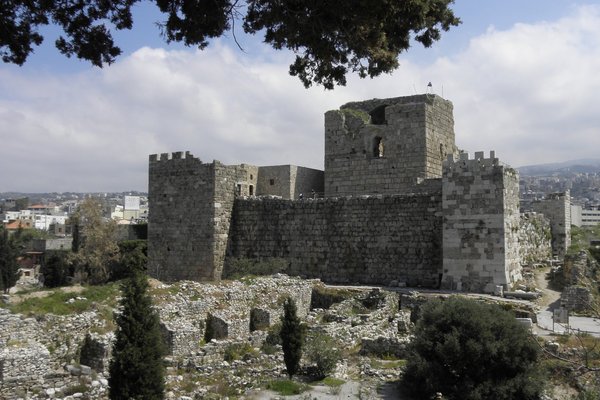Lebanon
Byblos
Byblos was an early Phoenician settlement and maritime commercial city, associated with the history of the diffusion of the Phoenician alphabet.
The town is believed to have been founded around 5,000 BCE, making it one of the oldest continuously inhabited sites in the world. Phoenician remains on-site include the Great Temple, the Temple of Baalat Gebal, and the Temple of the Obelisks. The archeological site holds successive layers of remains from the neolithic, chalcolithic, Assyrian, Roman, Byzantine, Muslim, and Crusader periods. The site also includes the current town of medieval and Ottoman origin.
Community Perspective: Byblos is the most touristy of Lebanon’s WHS and it has a pleasant coastal Mediterranean setting. The Crusader Castle is the dominant feature.
Site Info
Official Information
- Full Name
- Byblos (ID: 295)
- Country
- Lebanon
- Status
-
Inscribed 1984
Site history
History of Byblos
- 1984: Inscribed
- Inscribed
- Type
- Cultural
- Criteria
- iii
- iv
- vi
Links
- UNESCO
- whc.unesco.org
- Official
-
- visit-lebanon.org — VisitLebanon
- Related
-
- middleeast.com — Byblos
All Links
UNESCO.org
- whc.unesco.org — whc.unesco.org/
Official Website
- visit-lebanon.org — VisitLebanon
Related Resources
- middleeast.com — Byblos
News Article
- Sept. 10, 2006 seattlepi.nwsource.com — After the bombs, environmental calamity
Community Information
- Community Category
- Urban landscape: Arabic and Middle Eastern
Travel Information
Lebanon hotspot
Recent Connections
-
Asterix
Features in L'Odyssée d'Astérix.
-
No Map
-
Foreigner prices
6000 Lebanese pounds for foreigners, 40…
Connections of Byblos
- Individual People
-
-
Lawrence of Arabia
Visited
-
- Trivia
-
-
In the Louvre
The Yehawmilk steleSee www.louvre.fr
-
- History
-
-
The Crusades
"In the 12th and 13th century, Byblos became part of the County of Tripoli, a Crusader state connected to, but largely independent from, the Crusader Kingdom of Jerusalem." (wiki) From that period, the Fort and Church of St. John-Mark remain.See en.wikipedia.org
-
Assyrian Empire
Subject to Assyrian kings in the 8th and 7th century BCSee en.wikipedia.org
-
Oldest continuously inhabited cities
Byblos, Chalcolithic (3000 BC) -
Phoenician world
Phoenician city-state -
Republic of Genoa
-
Via Maris
-
Amarna Letters
-
Oldest Buildings
5000BC "the site of Byblos has been continuously inhabited since the Neolithic period. The oldest human settlement, some 7,000 years old, appears to have been a fishing village whose numerous monocellular huts have been rediscovered" (UNESCO). "To the south of the site is the Neolithic...enclosure. The crushed limestone floors and low retaining walls can still be seen" (Lonely Planet). The French archaeologist Dunand excavated at Byblos between 1924-75 and discovered the Neolithic dwellings. This link provides descriptions and a discussion on dating which suggests that the habitation started c600 years earlier than 5000BC -
Neolithic age
"Continuously inhabited since Neolithic times" (OUV)
-
- World Heritage Process
- Religion and Belief
-
-
Syriac Churches
St John the Baptist Church is now Maronite -
Mentioned in the Bible
It is mentioned in the Bible in 1 Kings 5:18, referring to the nationality of the builders of Solomon's Temple, and also in Ezekiel 27:9, referring to the riches of Tyre. -
Eastern Catholic Churches
St John the Baptist Church is now Maronite
-
- Human Activity
-
-
Festivals
Byblos International Festival -
Sea Ports
-
Writing systems
Byblos is also directly associated with the history and diffusion of the Phoenician alphabet. (AB ev)
-
- Constructions
-
-
Tombs
Ahiram's Tomb -
Obelisk
Temple of the Obelisks: " The temple's name, given by Dunand, refers to a number of obelisks and standing stones located in a court around the cella. The Abishemu obelisk has been interpreted to include a dedication to Resheph, a Canaanite war god, although this is disputed. Another obelisk has a hieroglyphic inscription Middle Bronze Age king of Byblos Ibishemu, praising the Egyptian god Herysha." (wiki)See en.wikipedia.org
-
Horse Stables
The former Crusade cathedral was used as horse stables by the Arabs. -
Theatres and Opera Houses
Roman Theatre
-
- WHS on Other Lists
-
-
Memory of the World
The Phoenician Alphabet
-
- Timeline
-
-
Built in the 3rd Millennium BC
Beginnings of the Phoenician civilization - "During the 3rd millennium BC, the first signs of a town can be observed, with the remains of well-built houses of uniform size. This was the period when the Phoenician civilization began to develop." (AB ev)
-
- WHS Hotspots
-
-
Lebanon hotspot
Lebanon Hotspot
-
- Visiting conditions
-
-
Foreigner prices
6000 Lebanese pounds for foreigners, 4000 for LebaneseSee www.mot.gov.lb
-
- Literature & Film
-
-
Asterix
Features in L'Odyssée d'Astérix.
-
News
- seattlepi.nwsource.com 09/10/2006
- After the bombs, environmental cal…
Recent Visitors
Visitors of Byblos
- Afshin Iranpour
- Alexander Barabanov
- Alexander Lehmann
- Ali Zingstra
- Ammon Watkins
- Ask Gudmundsen
- Aspasia
- Atila Ege
- AYB
- bergecn
- Bill Maurmann
- Bin
- Boj
- Bram de Bruin
- Chantal den Haan
- chapnis
- Christian Wagner
- Christoph
- Christravelblog
- Cirene Moraes
- Delphine Delaunay
- Dimitar Krastev
- edstar500
- Els Slots
- Erik Jelinek
- Errol Neo
- Eva Kisgyorgy
- Fan Yibo
- Fmaiolo@yahoo.com
- Gabor
- George Gdanski
- giloudepuertorico
- Hadrianus
- Hammeel
- Harry Mitsidis
- henryjiao18
- Iain Jackson
- Ivan Rucek
- Jarek Pokrzywnicki
- Jeffrey Chai
- João Aender
- Joyce van Soest
- Juha Sjoeblom
- Ken DJ
- Knut
- Krijn
- Lado Joel
- Little Lauren Travels
- Loic Pedras
- Luis Filipe Gaspar
- Lukasz Palczewski
- Maciej Gil
- Malgorzata Kopczynska
- marcel staron
- Marcobrey
- Martina Rúčková
- Michael Novins
- Mikan22
- Milan Jirasek
- Miloš Tašković
- MMM
- Monica66
- MoPython
- Morodhi
- Nihal Ege
- palka25
- Peltzi
- Persian Globetrotter
- PeterA
- PeterH
- Philipp Leu
- Philipp Peterer
- Qin Xie
- Randi Thomsen
- Remski
- Rodinia
- Roger Ourset
- Roman Bruehwiler
- Sergio Arjona
- Solivagant
- Stanislaw Warwas
- Svein Elias
- Szabolcs Mosonyi
- Szucs Tamas
- Tarquinio_Superbo
- Thomas Buechler
- Thomas van der Walt
- Timothy C Easton
- tony0001
- triath
- Truls Brekke
- Vernon Prieto
- Walter
- Westwards
- Xiquinho Silva
- Yongcheng Liu
- Zoë Sheng
Community Reviews
Show full reviews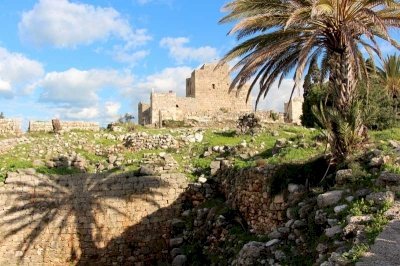
Visit: January 2019. Byblos is a good place to start a Lebanon WHS trip. I arrived at night, after an easy 45min drive from Beirut airport. Be aware that the same trip during the day can take 2-3 times longer due to heavy traffic in and around Beirut. To add another bonus, accommodation in Byblos was also cheaper and I could park my car in front of the hotel, close to the core zone.
The site opened at 8am and I must say I really liked it. As usual, I was the first visitor on site and enjoyed unspoiled views over the area. I can’t add much about what to see within the archeological zone. It’s a mix of remains from different cultures and times with the Crusader Castle as the dominant feature. It took me around 2 hours to see it all.
Outside the ticketed zone there is a tiny fort at the harbor and a roman street with columns in the new part of the town. They are both within walking distance. The “old souq” is very small and rather a zone for restaurants. The town is very touristy, so you won’t have trouble finding food or an ATM.
From Byblos you can easily reach several TWHS (Batroun, Tripoli) and the Qadisha Valley.
Keep reading 0 comments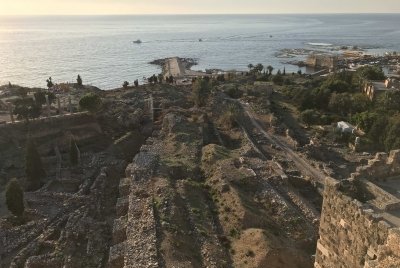
Byblos is one of the towns that, along with likes of Jericho, Damascus, Plovdiv and Athens claim to be the oldest continously inhabited cities of the world. As far as Lebanon goes, it's the easiest one to visit, a chilled under-an-hour drive up north from Beirut. Well, as long as you won't get stuck in traffic jams, that are especially painful in the evenings (we enjoyed them on our way back). The town is very touristy and milking its potential to the last drop. There's a free parking spot that's well signposted, or, if you fancy yourself very lazy, you can make use of the vallet parking right by the entrance, we spent about 3 euros on that.
The site itself is pretty, but a bit of a mishmash of everything: a crusader castle with lovely views from the top and then Roman ruins. Including one of the smallest theatres I've seen. The site is quite extensive, you can choose which parts to explore. There are signposts in multiple languages around. The castle doubles as the museum with some excavated exhibits. It's the most touristy of Lebanese WHSs, many people around, so visit early to beat the crowds. We visited en route from Qadisha valley, used the offline maps as the highway exit and the whole road is not that well signposted. Oh and if you want to stock up on souvenirs, this is the place to do so.
Keep reading 0 comments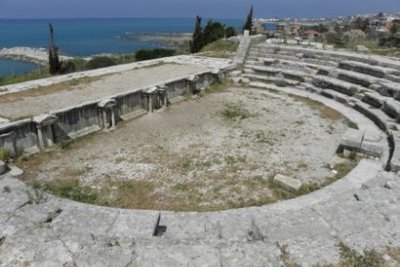
Although Byblos (nowadays known as ‘Jbeil’) lies only 35 km north of Beirut, it took the rickety local bus number 6 more than 1.5 hours to get me there. As always in Beirut we got stuck in traffic, and then slowly proceeded through casino-town Jounieh until we reached the Mediterranean. Finally, we were leaving the highrise buildings and American fast food restaurants behind. The drive northwards along the coast is quite pleasant, though many good spots have been taken over by large beach hotels and exclusive fish restaurants. The bus driver dumped me at an overpass, from where I walked down into the city center of Byblos.
It is not difficult to find your way to the archeological site: just walk to the Crusader Castle, which is the highest building in the area. After paying the ´foreigners´ entrance fee of 8000 LBP (4 EUR), I started the long circuit of the complex. Paths lead to all corners of the site, with information boards in English, French, and Arabic to explain what once was here. The origins of Byblos lie in the neolithic and chalcolithic, so remains of this period are limited. Better preserved is the Roman heritage: a small theatre at a splendid location overlooking the sea, and a row of columns along a former Roman road. At the far end of the complex lies the Temple of the Obelisks, an Egyptian/Phoenician construction. A group of obelisks still is standing upright, which makes it look like a cemetery.
…
Keep reading 0 comments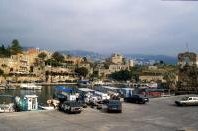
Byblos is apparently/claims to be the “oldest continuously inhabited town in the world”. The “idea” is however more impressive than the reality. It is a pleasant enough town with bustling little harbour overlooked by the remains of a crusader castle (photo) – much like many a small town around the Mediterranean. On the hill by the castle there is an archaeological site with a range of ruins from Roman times going back to Bronze Age and Neolithic but in all honesty there is not a lot to see. If you have made it to Lebanon however you should go up there – it is an easy trip out of Beirut either as part of a circuit up to the Cedars of Lebanon or as a return trip. It is all very relaxed and there are some good restaurants and pleasant cafes.
Keep reading 0 comments
